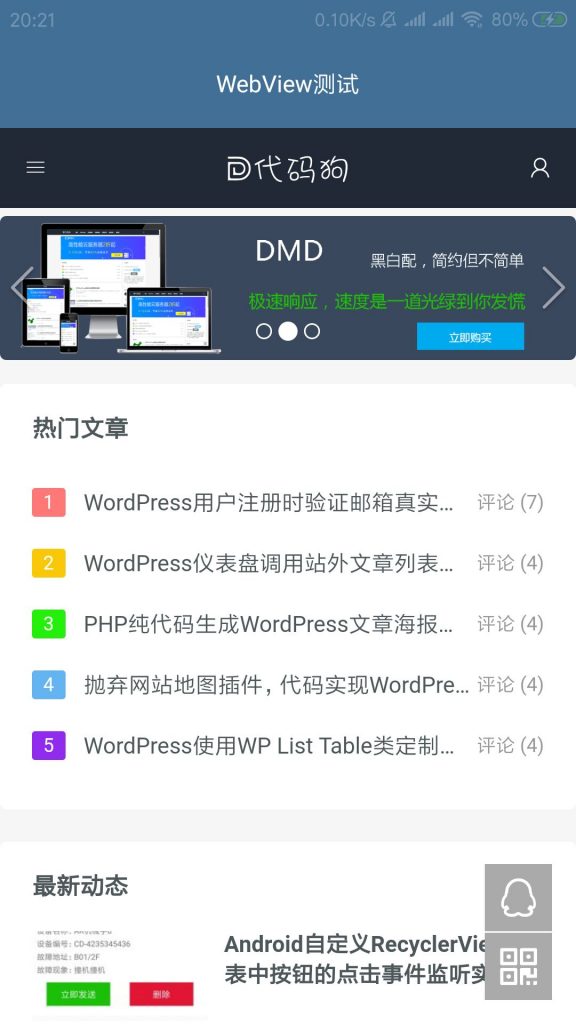以前一直没管过UI,最近因为一个安卓软件做得太丑被好多同事吐槽,我一个不会UI的人让我怎么写得好看?只能使用现成的UI框架,比如腾讯的QMUI框架就不错,就是腾讯的说明文档实在是有点坑,跟X5浏览服务一样,必须仔细阅读才能理解到开发者的意思,而且都TM不写使用方法,给个demo自己看例子去,擦,大厂真的屌!花了我几个小时看demo,成功将UI弄得好看了些,勉强先用着吧。这里写个简单的例子,给大家分享下使用QMUI腾讯UI框架实现安卓通知栏沉浸效果。
QMUI Android介绍
QMUI Android 的设计目的是用于辅助快速搭建一个具备基本设计还原效果的 Android 项目,同时利用自身提供的丰富控件及兼容处理,让开发者能专注于业务需求而无需耗费精力在基础代码的设计上。不管是新项目的创建,或是已有项目的维护,均可使开发效率和项目质量得到大幅度提升。
Android Studio添加依赖
implementation 'com.qmuiteam:qmui:1.2.0'配置主题样式
修改你的项目的style.xml文件中关于AppTheme的parent地址,如下所示
<!-- Base application theme. -->
<style name="AppTheme" parent="Theme.AppCompat.Light.DarkActionBar">
<!-- Customize your theme here. -->
<item name="colorPrimary">@color/colorPrimary</item>
<item name="colorPrimaryDark">@color/colorPrimaryDark</item>
<item name="colorAccent">@color/colorAccent</item>
</style>修改为
<!-- Base application theme. -->
<style name="AppTheme" parent="QMUI.Compat.NoActionBar">
<!-- Customize your theme here. -->
<item name="colorPrimary">@color/colorPrimary</item>
<item name="colorPrimaryDark">@color/colorPrimaryDark</item>
<item name="colorAccent">@color/colorAccent</item>
</style>注意对比哟,到此引入QMUI框架成功,下面看看上图是怎么实现的。
XML布局
<?xml version="1.0" encoding="utf-8"?>
<com.qmuiteam.qmui.widget.QMUIWindowInsetLayout
xmlns:android="http://schemas.android.com/apk/res/android"
android:layout_width="match_parent"
android:layout_height="match_parent"
android:background="?attr/qmui_config_color_background">
<com.qmuiteam.qmui.widget.QMUITopBarLayout
android:id="@+id/topbar"
android:layout_width="match_parent"
android:layout_height="wrap_content"
android:fitsSystemWindows="true">
</com.qmuiteam.qmui.widget.QMUITopBarLayout>
<com.qmuiteam.qmui.widget.webview.QMUIWebViewContainer
android:id="@+id/webview_container"
android:fitsSystemWindows="true"
android:layout_marginTop="?attr/qmui_topbar_height"
android:layout_width="match_parent"
android:layout_height="match_parent">
</com.qmuiteam.qmui.widget.webview.QMUIWebViewContainer>
</com.qmuiteam.qmui.widget.QMUIWindowInsetLayout>QDWebView控件类,这个你可以不用它,使用Android自带的webview也是一样的,我这里直接拿的官方demo中的代码。
public class QDWebView extends QMUIWebView {
public QDWebView(Context context) {
this(context, null);
}
public QDWebView(Context context, AttributeSet attrs) {
this(context, attrs, android.R.attr.webViewStyle);
}
public QDWebView(Context context, AttributeSet attrs, int defStyleAttr) {
super(context, attrs, defStyleAttr);
init(context);
}
@SuppressLint("SetJavaScriptEnabled")
protected void init(Context context) {
WebSettings webSettings = getSettings();
webSettings.setJavaScriptEnabled(true);
webSettings.setSupportZoom(true);
webSettings.setBuiltInZoomControls(true);
webSettings.setDefaultTextEncodingName("GBK");
webSettings.setUseWideViewPort(true);
webSettings.setLoadWithOverviewMode(true);
webSettings.setDomStorageEnabled(true);
webSettings.setCacheMode(WebSettings.LOAD_NO_CACHE);
webSettings.setTextZoom(100);
if (Build.VERSION.SDK_INT >= Build.VERSION_CODES.LOLLIPOP) {
webSettings.setMixedContentMode(WebSettings.MIXED_CONTENT_COMPATIBILITY_MODE);
}
String screen = QMUIDisplayHelper.getScreenWidth(context) + "x" + QMUIDisplayHelper.getScreenHeight(context);
String userAgent = "QMUIDemo/" + QMUIPackageHelper.getAppVersion(context)
+ " (Android; " + Build.VERSION.SDK_INT
+ "; Screen/" + screen + "; Scale/" + QMUIDisplayHelper.getDensity(context) + ")";
String agent = getSettings().getUserAgentString();
if (agent == null || !agent.contains(userAgent)) {
getSettings().setUserAgentString(agent + " " + userAgent);
}
// 开启调试
if (BuildConfig.DEBUG && Build.VERSION.SDK_INT >= Build.VERSION_CODES.KITKAT) {
setWebContentsDebuggingEnabled(true);
}
}
public void exec(final String jsCode) {
if (Build.VERSION.SDK_INT >= Build.VERSION_CODES.KITKAT) {
evaluateJavascript(jsCode, null);
} else {
loadUrl(jsCode);
}
}
@Override
protected int getExtraInsetTop(float density) {
return (int) (QMUIResHelper.getAttrDimen(getContext(), R.attr.qmui_topbar_height) / density);
}
}下面就是使用了,MainActivity.java中的代码如下:
public class MainActivity extends AppCompatActivity {
private QMUITopBarLayout topbar;
private QMUIWebViewContainer qmuiwebcon;
QDWebView mWebView;
@Override
protected void onCreate(Bundle savedInstanceState) {
super.onCreate(savedInstanceState);
setContentView(R.layout.activity_main);
QMUIStatusBarHelper.translucent(this);
qmuiwebcon= (QMUIWebViewContainer) findViewById(R.id.webview_container);
topbar= (QMUITopBarLayout) findViewById(R.id.topbar);
topbar.setTitle("WebView测试").setTextColor(ContextCompat.getColor(this,R.color.qmui_config_color_white));
topbar.setBackgroundColor(ContextCompat.getColor(this,R.color.qmui_btn_blue_bg));
mWebView = new QDWebView(this);
boolean needDispatchSafeAreaInset = needDispatchSafeAreaInset();
qmuiwebcon.addWebView(mWebView, needDispatchSafeAreaInset);
mWebView.loadUrl("https://www.daimadog.org");
qmuiwebcon.setCustomOnScrollChangeListener(new QMUIWebView.OnScrollChangeListener(){
@Override
public void onScrollChange(View v, int scrollX, int scrollY, int oldScrollX, int oldScrollY) {
onScrollWebContent(scrollX, scrollY, oldScrollX, oldScrollY);
}
});
mWebView.setDownloadListener(new DownloadListener() {
@Override
public void onDownloadStart(String url, String userAgent, String contentDisposition, String mimetype, long contentLength) {
}
});
}
protected void onScrollWebContent(int scrollX, int scrollY, int oldScrollX, int oldScrollY) {
}
protected boolean needDispatchSafeAreaInset() {
return false;
}
}有些多余代码,不用管,不喜欢删掉就行了。任务栏沉浸主要使用了QMUI框架中的QMUITopBarLayout控件,网上有些网友使用的QMUITopBar控件,官方说QMUITopBarLayout对 QMUITopBar 的包裹类,并代理了 QMUITopBar 的方法。配合 QMUIWindowInsetLayout 使用,可使 QMUITopBar 在支持沉浸式状态栏的界面中顶部延伸到状态栏。
然后就使用安卓的写法,找到控件,使用QMUI框架提供的方法设置标题与背景色,这个很简单看上面的代码就知道了,最重要的是要写 QMUIStatusBarHelper.translucent(this);这句,才能沉浸通知栏!别忘了哟。






评论 (1)